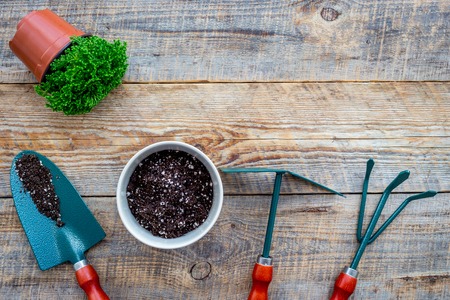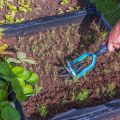1. Plan Your Garden Layout and Seed Orders
January is the perfect time to start fresh and map out your garden goals for the year. Before diving into new plans, take a moment to reflect on what worked well in last year’s garden and what didn’t. Did your tomatoes thrive but your lettuce bolt too early? Were there pests or weather issues that affected certain plants? Jot down these notes—they’ll help guide smarter decisions this season.
Sketch Out Your New Layout
Grab a notebook, a gardening journal, or use an online garden planner to sketch out your ideal garden layout. Think about crop rotation, spacing, and sunlight needs. Consider expanding raised beds, adding new containers, or experimenting with vertical gardening if space is limited.
Things to Include in Your Garden Layout:
- Sun exposure for each area
- Plant groupings (herbs, vegetables, flowers)
- Crop rotation from last year’s planting
- Paths for easy access and weeding
Know Your Planting Zone
If you’re not sure which USDA Hardiness Zone you live in, now’s the time to find out. Knowing your zone helps determine what plants will thrive in your climate and when to start seeds indoors or sow directly outdoors.
Quick Zone Reference Table:
| USDA Zone | Typical Last Frost Date | Seed Starting Time (Indoors) |
|---|---|---|
| Zone 5 | Mid-May | Mid-March |
| Zone 6 | Late April | Early March |
| Zone 7 | Mid-April | Late February |
| Zone 8+ | March or earlier | February or earlier |
Order Seeds Early
This is also the time to browse seed catalogs and place your orders. Popular varieties often sell out quickly, so ordering early ensures you get exactly what you want. Make a list of must-haves based on your layout plan, then add a few new varieties to try something different this year.
2. Prune Trees and Shrubs
January is a great time to get outside and give your deciduous trees and shrubs a little TLC. Since most of them are dormant this time of year, pruning now helps set the stage for strong, healthy growth in spring. By removing dead, damaged, or diseased branches, youre not only improving the plants shape but also preventing potential pest or disease problems later on.
Why Winter Pruning Works
When trees and shrubs are dormant, they experience less stress from pruning. Without leaves in the way, its also easier to see the structure of the branches and make clean cuts where needed. Plus, with pests and diseases less active in winter, theres a lower risk of infection at the cut sites.
What to Prune in January
| Plant Type | Pruning Tips |
|---|---|
| Deciduous Trees (like maples, oaks) | Remove crossing branches and thin crowded areas to improve airflow. |
| Flowering Shrubs (that bloom on new wood, like butterfly bush) | Cut back old stems to encourage fresh growth and more blooms. |
| Fruit Trees (like apple or pear) | Shape the canopy and remove suckers or water sprouts for better fruit production. |
Avoid Pruning These in January
Certain plants should be left alone until later in the season. Avoid pruning spring-flowering shrubs like lilacs and azaleas now—they bloom on old wood, so cutting them back too early can reduce flowers come spring.
Quick Tips for Successful Winter Pruning:
- Use clean, sharp tools to make smooth cuts.
- Aim to prune on dry days to prevent moisture-related diseases.
- Always cut just above a bud facing the direction you want new growth to go.
If youre unsure whether a branch is dead or alive, try scraping a small section of bark with your fingernail—green underneath means its still living. Happy pruning!
![]()
3. Prepare Garden Beds and Tools
January is the perfect time to get your garden beds and tools in top shape for the new growing season. Start by clearing out any leftover debris like fallen leaves, dead plants, or weeds from last year. Removing this clutter helps prevent pests and diseases from lingering in your garden.
Next, compost any old plant material that’s still healthy and disease-free. This not only reduces waste but also creates rich compost you can use later on. Once your beds are cleared, it’s time to improve your soil. Mix in compost or well-aged organic matter to boost nutrients and improve soil structure—your spring plants will thank you!
Soil Amendment Quick Guide
| Material | Benefits | How to Use |
|---|---|---|
| Compost | Adds nutrients and improves drainage | Mix 2–3 inches into top 6 inches of soil |
| Aged Manure | Boosts nitrogen and organic matter | Apply a thin layer and mix into soil before planting |
| Peat Moss | Improves moisture retention in sandy soils | Add 1–2 inches and blend well with existing soil |
Don’t forget about your tools! Sharp, clean tools make gardening easier and more efficient. Use a wire brush or cloth to remove dirt and rust from blades, then sharpen pruners, shears, and shovels as needed. Applying a little oil to metal parts can help prevent rust during storage.
Basic Tool Care Checklist
- Clean off dirt and sap after each use
- Sharpen cutting edges with a file or sharpening stone
- Oil metal parts to prevent rusting
- Tighten any loose screws or bolts
With tidy garden beds and ready-to-go tools, you’ll be set up for a productive gardening season ahead!
4. Start Indoor Seedlings
January might be chilly outside, but its the perfect time to get a jump on your spring garden by starting seeds indoors. Cool-season crops like lettuce, broccoli, and onions thrive when started early inside and later transplanted outdoors once the weather warms up.
Why Start Seeds Indoors?
Starting seedlings indoors gives you a head start on the growing season. It allows plants more time to mature before the outdoor planting window opens. Plus, it helps you avoid late frosts that can damage tender young plants.
What Youll Need
| Item | Purpose |
|---|---|
| Seed trays or small pots | To hold soil and seeds |
| Seed-starting mix | Lightweight soil for healthy roots |
| Grow lights or sunny window | Provide enough light for seedlings |
| Spray bottle or watering can | Keep soil moist but not soggy |
| Seeds of cool-weather crops | Lettuce, broccoli, onions, etc. |
Best Crops to Start Indoors in January
- Lettuce – Quick-growing and perfect for early harvests
- Broccoli – Needs extra time to develop before transplanting
- Onions – Benefit from a long indoor growing period
Tips for Success
- Place grow lights 2-4 inches above seedlings and adjust as they grow
- Use a timer to give plants 12-16 hours of light per day
- Label each tray with plant type and date sown
- Avoid overwatering—keep the soil damp but not soaked
With just a little effort now, youll have strong, healthy transplants ready to go into the ground when spring arrives. Happy indoor gardening!
5. Protect Winter Plants and Monitor for Pests
Even though your garden may seem dormant in January, your winter plants still need care and attention. Cold temperatures, fluctuating weather, and overwintering pests can all pose risks to your garden’s health. Taking a few simple steps now can keep your perennials and root crops safe and strong until spring.
Check Mulch Around Perennials and Root Crops
Mulch acts as insulation for plant roots during cold snaps. In areas with freezing temps, its important to ensure mulch layers are thick enough (usually 2–4 inches) to protect perennials like hostas, daylilies, and root vegetables such as carrots or beets that may still be in the ground.
Quick Mulch Check Guide
| Plant Type | Recommended Mulch Depth | Notes |
|---|---|---|
| Perennials (e.g., daylilies) | 2–3 inches | Avoid piling mulch against plant crowns |
| Root crops (e.g., carrots) | 3–4 inches | Use straw or shredded leaves for easy removal |
| Shrubs & young trees | 3 inches | Keep mulch 2–3 inches away from trunk base |
Inspect for Overwintering Pests
Pests like aphids, spider mites, and slugs don’t take the winter off — they often hide under leaves or in mulch layers. Take time this month to gently lift mulch or covers and look for signs of pest activity such as chewed leaves, tiny webs, or eggs.
Pest Monitoring Tips
- Look under plant leaves and around base stems for insects or eggs.
- Check stored bulbs or tubers for rot or larval damage.
- If you use row covers or cloches, open them on sunny days to reduce moisture buildup.
Adjust Covers and Cloches Based on Weather Patterns
If youre using floating row covers, cold frames, or cloches to protect your plants, make sure they’re secure but also allow proper ventilation. In milder zones like USDA Zones 8–10, you may need to open covers during warm spells to prevent overheating.
Weather-Based Cover Adjustment Chart
| Condition | What to Do |
|---|---|
| Heavy snow forecasted | Add extra cover or reinforce existing protection |
| Mild sunny days (above 50°F) | Open covers for a few hours to ventilate and dry soil |
| Windy days | Secure covers with weights or stakes to prevent shifting |
A little effort now goes a long way in keeping your garden healthy through the rest of winter. By checking mulch layers, monitoring for pests, and adjusting protective coverings based on local conditions, you’ll set yourself up for a thriving garden when spring arrives.


